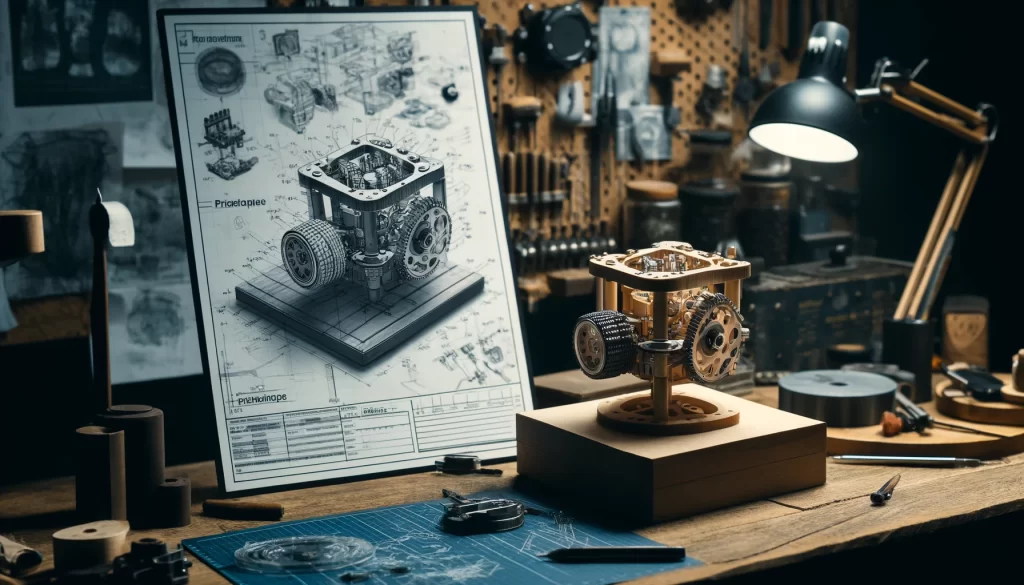**Disclosure:** We believe in honesty and transparency to the fullest extent. Some of the links on this blog are affiliate links, meaning, at no additional cost to you, we will earn a commission if you click through and make a purchase. This is one of the simplest ways you can support us.
Turning an inventive idea into a marketable product is a journey filled with opportunities and challenges. As an aspiring entrepreneur, understanding the various routes to bring your invention to life or license it can significantly impact your success. It’s important to know only about 13% of inventions are commercially successful, highlighting the challenges inventors face in bringing their ideas to market (Viima). This article explores different pathways you can take to transform your invention from concept to reality, offering insights into direct-to-market strategies and licensing alternatives. By evaluating these routes, you can choose the best path based on your goals, resources, and market potential.
1. Direct-to-Market Route

A. Developing the Product Yourself
Steps to Create a Prototype
Creating a prototype is the first tangible step in bringing your invention to life. Start by sketching your idea and developing a detailed concept description. Use materials at hand or consider 3D printing to create a basic model. This initial prototype will help you identify design flaws and functional improvements.

Importance of Market Research and Validation
Conduct thorough market research to understand your target audience, industry trends, and competitors. Validate your idea by seeking feedback from potential customers and industry experts. This validation process is crucial to ensure there is a demand for your invention and to refine your concept based on real-world insights.
Detailed Product Development and Refinement
Once your prototype is validated, proceed with detailed product development. This involves refining the design, selecting appropriate materials, and ensuring the product meets safety and regulatory standards. Collaborate with engineers, designers, and other professionals to perfect your invention before moving to production.
B. Setting Up Your Own Business

Creating a Business Plan
A comprehensive business plan outlines your business model, target market, competitive analysis, marketing strategy, and financial projections. It serves as a roadmap for your venture and is essential for securing funding. Detail your product’s unique selling points and how you plan to achieve market penetration.
Securing Funding (Bootstrapping, Investors, Loans)
Evaluate different funding options based on your needs and business plan. Bootstrapping involves using personal savings or revenue from early sales to fund your business. Alternatively, seek investors by pitching your idea to venture capitalists or angel investors. Consider business loans or grants as other viable options to finance your production and marketing efforts.
Building a Team and Infrastructure
As your business grows, build a team of skilled professionals who share your vision. Hire experts in areas such as marketing, finance, and operations to ensure all aspects of your business are well-managed. Establishing a solid infrastructure, including office space, technology, and production facilities, is crucial for smooth operations and scalability.
C. Manufacturing and Production

Finding Manufacturers and Suppliers
Identify reliable manufacturers and suppliers who can produce your product at the desired quality and scale. Research and vet potential partners to ensure they meet your standards and can deliver on time. Building strong relationships with manufacturers and suppliers is key to maintaining product quality and managing costs.
Managing Production Quality and Costs
Implement quality control measures to ensure your product meets customer expectations and industry standards. Regularly review production processes to identify areas for cost savings without compromising quality. Efficient production management helps maintain profitability and customer satisfaction.
Scaling Production Based on Demand
As demand for your product grows, scale production accordingly. Monitor sales data and market trends to forecast demand and adjust production schedules. Scaling production efficiently ensures you can meet customer demand without overextending your resources.
D. Marketing and Sales
Crafting a Marketing Strategy
Develop a comprehensive marketing strategy that includes branding, advertising, and promotional activities. Define your brand’s identity and value proposition, and create compelling messaging to attract your target audience. Utilize various marketing channels, including social media, email marketing, and content marketing, to reach potential customers.
Leveraging Online and Offline Sales Channels
Establish a strong online presence through an e-commerce website and online marketplaces. Consider selling your product through retail stores or pop-up shops to reach a broader audience. Diversifying your sales channels enhances visibility and accessibility, driving more sales.
Utilizing Social Media and Digital Marketing
Harness the power of social media to build a community around your brand. Use platforms like Instagram, Facebook, and LinkedIn to engage with potential customers, share updates, and gather feedback. Implement digital marketing tactics such as search engine optimization (SEO), pay-per-click (PPC) advertising, and influencer partnerships to increase your online reach and drive traffic to your sales channels.
2. Licensing Your Invention

A. Understanding Licensing
Definition and Benefits of Licensing
Licensing involves granting another company the rights to manufacture, distribute, and sell your invention in exchange for royalties or a lump sum payment. This approach can be beneficial if you prefer not to handle the complexities of production and marketing yourself. Licensing allows you to leverage the licensee’s existing infrastructure, expertise, and market reach, potentially bringing your product to market faster and with less financial risk.
Types of Licensing Agreements
There are various types of licensing agreements, including exclusive, non-exclusive, and co-exclusive licenses. An exclusive license grants one licensee the sole rights to your invention, while a non-exclusive license allows multiple companies to use your invention simultaneously. A co-exclusive license involves two or more licensees sharing the rights. Each type has its advantages and should be chosen based on your strategic goals and market conditions.
B. Preparing Your Invention for Licensing
Protecting Your Intellectual Property
Before seeking a licensing agreement, ensure your invention is protected through patents, trademarks, or copyrights. This legal protection prevents others from copying or using your idea without permission, making your invention more attractive to potential licensees. Consulting with a patent attorney can help you navigate the complexities of IP protection.
Creating a Compelling Licensing Pitch
Develop a strong pitch to present your invention to potential licensees. Highlight the unique features, market potential, and benefits of your invention. Include data from market research, prototype demonstrations, and testimonials from potential customers. A compelling pitch should clearly communicate the value of your invention and why it would be a profitable addition to the licensee’s product portfolio.
Developing a Prototype or Detailed Concept
Having a working prototype or a detailed concept of your invention is crucial when approaching potential licensees. This tangible demonstration helps them understand the functionality and market potential of your invention. Ensure your prototype is polished and showcases the key features and benefits effectively.
C. Finding Potential Licensees
Identifying Companies Interested in Your Invention
Research and identify companies within your industry that could benefit from your invention. Look for companies with a track record of licensing products similar to yours. Networking at industry events, trade shows, and professional associations can also help you connect with potential licensees.
Approaching Potential Licensees and Presenting Your Idea
Once you’ve identified potential licensees, reach out to them with a well-crafted pitch. Request meetings to present your invention and discuss potential licensing opportunities. Be prepared to negotiate terms and answer questions about your invention’s market potential, production feasibility, and IP protection.
Negotiating Licensing Agreements
Negotiate terms that are favorable to both parties. Key aspects to consider include royalty rates, payment schedules, duration of the agreement, and any performance milestones. Consulting with a licensing attorney can help you navigate these negotiations and ensure you secure a fair and beneficial agreement.
D. Managing the Licensing Relationship

Monitoring the Use of Your Invention
Once an agreement is in place, monitor how the licensee is using your invention. Ensure they are adhering to the terms of the agreement and maintaining product quality. Regular check-ins and open communication can help address any issues promptly.
Handling Royalty Payments and Contractual Obligations
Establish a clear system for tracking and receiving royalty payments. Ensure all contractual obligations are being met by both parties. Address any discrepancies or breaches of contract swiftly to maintain a positive and productive relationship.
Maintaining Good Relationships with Licensees
Building and maintaining a good relationship with your licensees is crucial for long-term success. Provide support and collaborate on marketing efforts if needed. A strong partnership can lead to future licensing opportunities and mutual growth.
3. Partnering with a Manufacturer or Distributor
A. Co-Development Agreements
Collaborating with Manufacturers to Develop Your Product
Partnering with a manufacturer for co-development can reduce the financial and technical burden of bringing your invention to market. This collaborative approach allows you to leverage the manufacturer’s expertise in production, design, and logistics. Clearly define roles, responsibilities, and financial contributions in a co-development agreement to ensure a smooth partnership.
Sharing Costs and Risks
Co-development agreements often involve sharing the costs and risks associated with product development. This arrangement can make it easier to manage expenses and navigate challenges. Both parties benefit from the success of the product, fostering a collaborative and mutually beneficial relationship.
B. Distribution Partnerships

Partnering with Distributors to Handle Sales and Logistics
Distributors can help you reach a wider market by leveraging their established sales networks and logistical capabilities. Partnering with a distributor allows you to focus on product development while they handle the complexities of sales, warehousing, and shipping. Choose distributors with a strong market presence and a good reputation.
Benefits of Leveraging Existing Distribution Networks
Using existing distribution networks can significantly reduce time-to-market and increase your product’s reach. Distributors often have established relationships with retailers and a deep understanding of market dynamics. This expertise can help you navigate the complexities of getting your product into the hands of customers efficiently and effectively.
4. Crowdfunding and Community Support

A. Utilizing Crowdfunding Platforms
Choosing the Right Platform (Kickstarter, Indiegogo)
Crowdfunding platforms like Kickstarter and Indiegogo provide a way to raise funds while validating your product concept. Each platform has its own strengths and community focus, so choosing the right one depends on your product type and target audience. Kickstarter is ideal for creative projects and tech gadgets, while Indiegogo offers more flexibility and options for various project types.
Creating a Compelling Campaign
A successful crowdfunding campaign requires a compelling story, attractive rewards, and a clear funding goal. Start by creating a captivating video that showcases your invention, its benefits, and the problem it solves. Detail the development process, your passion for the project, and why you need backer support. Offer a range of rewards, from thank-you notes to early-bird discounts, to incentivize contributions.
Managing Backer Relationships and Fulfillment
Maintaining open and transparent communication with your backers is crucial throughout the campaign and beyond. Provide regular updates on your progress, addressing any challenges and celebrating milestones. Once the campaign ends, focus on fulfilling rewards promptly and maintaining high-quality standards. Efficient fulfillment is key to building trust and a positive reputation, which can lead to repeat customers and future support.
B. Building a Supportive Community
Engaging with Early Adopters and Advocates
Early adopters and advocates can be your biggest supporters and promoters. Engage with them through social media, email newsletters, and community events. Encourage them to share their experiences and feedback, creating a sense of involvement and ownership. Their testimonials and word-of-mouth promotion can significantly boost your product’s credibility and reach.
Using Social Media to Build Momentum
Social media platforms are powerful tools for generating buzz and building a community around your invention. Create profiles on relevant platforms and share engaging content regularly. Use a mix of posts, including behind-the-scenes updates, user testimonials, and interactive content like polls and Q&A sessions. Leverage hashtags, influencers, and paid advertising to expand your reach and attract more followers.
Gathering Feedback and Iterating on Your Product
Feedback from your community is invaluable for refining and improving your product. Encourage backers and followers to provide input on design, functionality, and usability. Use this feedback to make necessary adjustments and improvements before the final launch. This iterative process ensures your product meets customer expectations and stands out in the market.
By leveraging crowdfunding and community support, you can raise funds, validate your product concept, and build a loyal customer base. These routes provide not only financial backing but also valuable market insights and promotional support, setting the stage for a successful product launch.
5. Incubators and Accelerators

A. Applying to Programs
Finding Relevant Incubator and Accelerator Programs
Incubators and accelerators provide resources, mentorship, and funding to help startups grow and succeed. Research programs that align with your industry and the stage of your invention. Many programs focus on specific sectors, such as technology, healthcare, or consumer products. Look for those with a strong track record of supporting successful startups and a network of experienced mentors and investors.
Preparing a Strong Application
A compelling application is key to getting accepted into an incubator or accelerator program. Clearly articulate your invention’s value proposition, market potential, and development progress. Highlight your team’s expertise and the unique advantages of your product. Provide detailed financial projections and a roadmap for growth. Tailor your application to each program, emphasizing how their resources and support will help you achieve your goals.
Benefits of Mentorship, Funding, and Resources
Participating in an incubator or accelerator offers numerous benefits, including access to funding, mentorship, and industry connections. Mentors can provide valuable guidance on product development, business strategy, and market entry. Programs often offer seed funding or help secure investment from venture capitalists and angel investors. Additionally, you’ll have access to resources such as office space, legal support, and technical assistance.
B. Leveraging Program Support

Taking Advantage of Networking Opportunities
Networking is a crucial component of incubator and accelerator programs. Engage with other startups, mentors, and industry experts to build relationships and exchange knowledge. Attend workshops, seminars, and networking events to expand your professional network. These connections can lead to partnerships, collaborations, and new opportunities for your invention.
Accessing Funding and Investment Options
Many programs provide direct funding or facilitate introductions to potential investors. Use these opportunities to secure the necessary capital for product development, marketing, and scaling. Prepare a compelling pitch and business plan to present to investors, demonstrating your invention’s potential for growth and profitability. Leverage the program’s reputation and network to increase your chances of securing investment.
Using Program Resources for Development and Scaling
Take full advantage of the resources offered by incubator and accelerator programs. Use their office space and facilities to reduce overhead costs. Access technical support for product development and testing. Utilize legal and administrative assistance to navigate regulatory requirements and protect your intellectual property. These resources can significantly accelerate your development process and position your invention for market success.
By participating in an incubator or accelerator, you gain access to invaluable support and resources that can propel your invention forward. These programs offer a structured environment to refine your product, build your business, and connect with key stakeholders, increasing your chances of bringing your invention to market successfully.
6. Partnering with a Manufacturer or Distributor
A. Co-Development Agreements
Collaborating with Manufacturers to Develop Your Product
Partnering with a manufacturer can significantly ease the burden of product development. Co-development agreements allow you to share the responsibilities of designing, prototyping, and producing your invention. This collaboration leverages the manufacturer’s expertise in production processes and material sourcing, ensuring that your product is manufactured efficiently and to high-quality standards.
Sharing Costs and Risks
Co-development partnerships often involve sharing both the costs and risks associated with bringing a new product to market. This arrangement can reduce the financial strain on your startup and provide access to resources that might otherwise be out of reach. Clearly outline the terms of cost-sharing and risk management in your agreement to ensure mutual benefit and understanding.
B. Distribution Partnerships
Partnering with Distributors to Handle Sales and Logistics
Distribution partnerships allow you to focus on product development while your partner manages sales, logistics, and inventory management. Distributors have established networks and relationships with retailers, which can accelerate your product’s market entry and reach a broader audience. Choose distributors with a strong presence in your target markets and a reputation for reliability.
Benefits of Leveraging Existing Distribution Networks
By leveraging a distributor’s existing network, you can quickly scale your operations and ensure your product is available to customers through multiple channels. This approach reduces the complexities of supply chain management and allows you to benefit from the distributor’s logistical expertise, ultimately enhancing your product’s market penetration and customer satisfaction.
7. Legal and Regulatory Compliance

A. Ensuring Compliance with Industry Standards and Regulations
Understanding Regulatory Requirements
Navigating the regulatory landscape is crucial for bringing an invention to market. Different industries have specific standards and regulations that must be met to ensure safety, quality, and compliance. Conduct thorough research to understand the regulatory requirements applicable to your product. This may include health and safety standards, environmental regulations, and industry-specific certifications.
Working with Legal Experts
Engage legal experts who specialize in your industry to help you understand and comply with all relevant regulations. Legal counsel can assist in drafting and reviewing contracts, securing necessary certifications, and ensuring your product adheres to all legal standards. This step is vital to avoid potential legal issues and ensure smooth market entry.
B. Handling Legal Aspects Related to Business Operations
Protecting Your Intellectual Property
Securing intellectual property (IP) protection is essential to safeguard your invention from infringement. Apply for patents, trademarks, or copyrights to establish legal ownership of your innovation. Consult with an IP attorney to navigate the application process and develop a strategy to protect your IP rights both domestically and internationally.
Managing Contracts and Agreements
Drafting and managing contracts with suppliers, manufacturers, distributors, and other partners is a critical aspect of business operations. Ensure that all agreements clearly outline the terms, responsibilities, and expectations of each party. Regularly review and update contracts to reflect any changes in your business relationships or market conditions.
8. Post-Market Strategy
A. Monitoring Product Performance and Market Trends
Collecting and Analyzing Feedback
Once your product is on the market, actively collect feedback from customers to understand their experiences and satisfaction levels. Use surveys, reviews, and direct customer interactions to gather valuable insights. Analyze this feedback to identify areas for improvement and to inform future product development.
Tracking Sales and Market Trends
Monitor sales data and market trends to evaluate your product’s performance. Use analytics tools to track key performance indicators (KPIs) such as sales volume, market share, and customer acquisition costs. Staying informed about market trends and competitor activities will help you adapt your strategy and maintain a competitive edge.
B. Innovating and Iterating Based on Market Feedback
Continuous Improvement
Incorporate customer feedback and market insights into ongoing product improvement efforts. Regularly update and refine your product to address any issues and enhance its features. This iterative approach ensures that your product remains relevant and meets evolving customer needs.
Planning for Product Updates or New Product Lines
Develop a roadmap for future product updates or the introduction of new product lines. Consider expanding your product offerings based on market demand and customer feedback. This proactive approach to innovation will help you sustain growth and keep your brand fresh and competitive.
Conclusion
Bringing an invention to market involves navigating various routes, each with its own set of challenges and opportunities. Whether you choose to develop the product yourself, license your idea, partner with manufacturers, leverage crowdfunding, or participate in incubator programs, understanding the options available will help you make informed decisions. By carefully planning and executing your strategy, you can successfully transform your invention into a marketable product and achieve your entrepreneurial goals.










